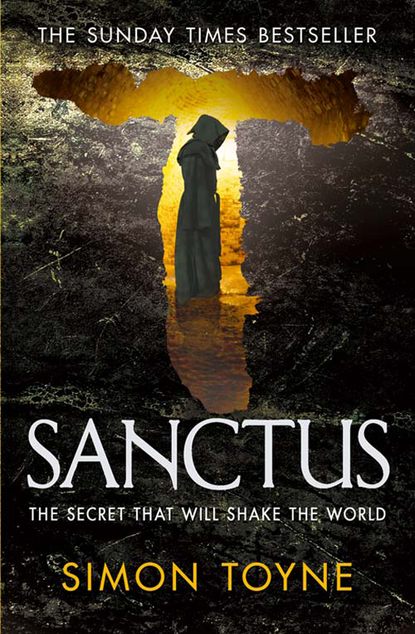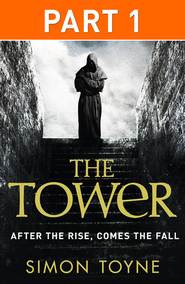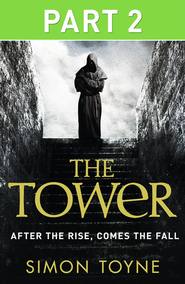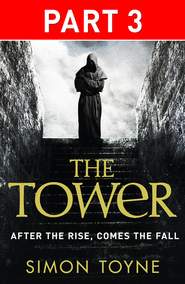По всем вопросам обращайтесь на: info@litportal.ru
(©) 2003-2025.
✖
Sanctus
Автор
Год написания книги
2018
Настройки чтения
Размер шрифта
Высота строк
Поля
‘Now, if anyone has any questions,’ he said, his brisk change of tone communicating his sincere wish that nobody did, ‘then ask away.’
His small, darting eyes pecked the blank faces of the crowd staring up at the huge building, trying to think of something to ask. Normally nobody could, which meant they would then have a full twenty minutes to wander around, buy some souvenirs and take bad photos before rendezvousing back at the coach to head off somewhere else. The guide had just drawn breath to inform them of this fact when a hand shot up and pointed skywards.
‘What’s that thing?’ a red-faced man in his fifties asked in a blunt northern British accent. ‘That thing as looks like a cross?’
‘Well, as I’ve already mentioned, the Citadel has no crosses anywhere on its –’
He stopped short. Squinted against the brightening sky. Looked again.
There above him, clearly visible on the famously unadorned summit of the ancient fortress, was a tiny cross.
‘You know, I’m not … sure what that is …’ He trailed off again.
No one was listening anyway. They were all straining their eyes to get a better glimpse of whatever was perched on top of the mountain.
The guide followed suit. Whatever it was wavered slightly. It looked like a capital letter ‘T’. Maybe it was a bird, or simply a trick of the morning light.
‘It’s a man!’ Someone shouted from another group standing nearby. The guide looked across at a middle-aged man, Dutch by his accent, staring intently at the fold-out LCD screen of his video camera.
‘Look!’ The man leaned back so others could share his discovery.
The guide peered at the screen over the jostling scrum. The camera had been zoomed in as far as it would go and held unsteadily on a grainy, digitally enhanced image of a man dressed in what looked like a green monk’s habit. His long, dark-blonde hair whipped round his bearded face, blown by the higher winds, but he stood perfectly still at the summit’s edge, his arms fully outstretched, his head tilted down, looking for all the world like a human cross – or a lonely, living figure of Christ.
9
In the foothills rising to the west of Ruin, in an orchard first planted in the late Middle Ages, Kathryn Mann led a group of six volunteers silently across the dappled ground. Each member of the group was dressed identically in an all-over body smock of heavy white canvas with a wide-brimmed hat dripping black gauze on every shoulder and shading every face. In the early morning light they looked like an ancient sect of druids on their way to a sacrifice.
Kathryn arrived at an upright oil drum covered with a scrap of tarpaulin and began removing the rocks holding it in place as the group fanned out silently behind her. The buoyant mood that had filled the minibus as it threaded its way through the empty, pre-dawn streets had long since evaporated. She removed the last of the weights. Someone held up the smoker for her. Usually the warmer the day the more active the bees became, and the more she needed to subdue them. Despite the building heat, Kathryn could already tell this hive was the same as the others. No hum sounded inside it and the dry red brick that served as a landing pad was empty.
She pumped a few cursory puffs of smoke into the bottom of the hive then lifted the tarp to reveal eight wood battens spaced evenly across the rim of the open drum. It was a simple top-bar hive; they could be made out of almost any old bits of salvage, as this one had been. The expedition to the orchard had been intended as a practical demonstration of basic bee-keeping, something the volunteers could put into practice in the various parts of the world they would be stationed in for the next year. But as dawn had broken and hive after hive was found and checked, the expedition turned into a first-hand encounter with something much more disturbing.
As the smoke cleared Kathryn lifted a side batten carefully from the drum and turned to the group. Hanging beneath it was a large, irregular-shaped honeycomb almost empty of honey; the hive had been successful and prosperous until very recently. Now, despite a handful of newly hatched worker bees crawling aimlessly across its waxy surface, the hive was deserted.
‘A virus?’ a male voice asked from under one of the shrouds.
‘No.’ Kathryn shook her head. ‘Take a look …’
They formed a tight circle around her.
‘If a hive is infected by CPV or APV, chronic or acute bee paralysis virus, then the bees shiver and can’t fly so they die in or around the hive. But look at the ground.’
Six hats dipped and surveyed the spongy grass growing thickly in the shade of the apple tree.
‘Nothing. And look inside the hive.’
The hats rose, their wide brims pushing against each other.
‘If a virus had caused this then the bottom of the hive would be deep with dead bees. They’re like us; when they feel sick they head home and hunker down until they feel better. But there’s nothing there. The bees have just vanished. There’s something else here too.’
She held the batten higher and pointed at the lower section of the honeycomb where the hexagonal cells were covered with tiny wax lids.
‘Un-hatched larvae,’ Kathryn said. ‘Bees don’t normally abandon a hive if there are still young to be hatched.’
‘So what happened?’
Kathryn slotted the comb back into the silent hive. ‘I don’t know,’ she said. ‘But it’s happening everywhere.’ She began walking back to the boarded-up cider-house at the edge of the orchard. ‘Same thing’s been reported in North America, Europe, even as far east as Taiwan. So far no one’s managed to work out what’s causing it. The only thing everyone does agree on is that it’s getting worse.’
She pulled off her gauntlets as she reached the minibus and dropped them into an empty plastic crate. Everyone followed suit.
‘In America they call it Colony Collapse Disorder. Some people think it’s the end of the world. Einstein said that if the bee disappeared from the face of the earth then we’d only have four years left. No more bees. No more pollination. No more crops. No more food. No more man.’
She unzipped her gauze face protector and slipped off her hat revealing an oval face with pale, clear skin and dark, dark eyes. She had an ageless, natural air about her that was vaguely aristocratic and was regularly the object of the young male volunteers’ fantasies, even though she was older than many of their mothers. She reached up with her free hand, unclipped a thick coil of hair the colour of dark chocolate and shook it loose.
‘So what are they doing about it?’ The enquirer – a tall, sandy-haired boy from the American Mid-West – emerged from beneath a bee smock. He had the look most volunteers had when they first came to work for Kathryn at the charity: earnest, un-cynical, full of health and hope, shining with the goodness of the world. She wondered what he would look like after a year in the Sudan watching children die slowly from starvation, or in Sierra Leone persuading starving villagers not to plough fields their great-grandfathers had worked because guerrillas had sown them with landmines.
‘They’re doing lots of research,’ she said, ‘trying to establish a link between the colony collapses and GM crops, new types of nicotinoid pesticides, global warming, known parasites and infections. There’s even a theory that mobile phone signals might be messing around with the bees’ navigational systems, causing them to lose their bearings.’
She shrugged off her smock and let it fall to the ground.
‘But what do you think it is?’ Kathryn looked up at the earnest young man, saw the beginnings of a frown etching itself on to a face that had barely known a moment’s concern.
‘Oh, I don’t know,’ she said. ‘Maybe it’s a combination of all these things. Bees are actually quite simple creatures. Their society is simple too. But it doesn’t take much to upset things. They can cope with stress, but if life becomes too complex, to the point where they don’t recognize their society any more, maybe they abandon it. Maybe they’d rather fly off to their deaths than stay living in a world they no longer understand.’
She looked up. Everyone had stopped squirming out of their smocks and now stood with worried expressions clouding their young faces.
‘Hey,’ Kathryn said, trying to lighten the mood, ‘don’t listen to me; I just spend too much time on Wikipedia. Besides, you saw it’s not happening to all the hives; more than half of them are buzzing fit to burst. Come on,’ she said, clapping her hands together and immediately feeling like a nursery teacher leading a bunch of five-year-olds in a sing-song. ‘Still got lots to do. Pack away your smocks and start breaking out the tools. We need to replace those dead hives.’ She flipped the lid off another plastic crate lying on the grass. ‘There’s everything you need in here. Tools, instructions on how to make a basic top-bar hive, bits of old boxes and lengths of timber. But remember, in the field you’ll be building hives from whatever you can scavenge. Not that you’ll find much lying around where you’ll be going. People who don’t have anything in the first place don’t tend to throw anything away.
‘You can’t use anything from the dead hives. If some kind of spore or parasite did cause the colony to fail, you’ll just import disaster to the new one.’
Kathryn pulled open the driver’s door. She needed to distance herself from the volunteers. Most of them came from educated, middle-class backgrounds, which meant they were well-meaning but impractical and would stand around discussing the best way of doing something for hours rather than actually doing it. The only way to cure them was to throw them in at the deep end and let them learn by their own mistakes.
‘I’ll check how you’re doing in half an hour. If you need me, I’ll be in my office.’ She slammed the door shut behind her before anyone could ask another question.
She could hear the dull clatter of tools being sorted and the first of many theoretical discussions. She turned on the radio. If she could hear what they were talking about, sooner or later the mother in her would compel her to assist and that wouldn’t help anybody. She wouldn’t be there for them in the field.
A local radio station drowned out the noise of the volunteers with traffic news and headlines. Kathryn reached over to the passenger seat and picked up a thick manila file. On the cover was a single word – Ortus – and the logo of a four-petal flower with the world at its centre. It contained a field report detailing a complex scheme to irrigate and replant a stretch of desert created by illegal forest clearances in the Amazon Delta. She had to decide today whether the charity could afford it or not. It seemed that every year, despite fundraising being at an all-time high, there were more and more bits of the world that needed healing.
‘And finally,’ the radio newscaster said with that slightly amused tone they always reserve for novelty items at the end of the serious stuff, ‘if you go down to the centre of Ruin today you’re sure of a big surprise – because somebody dressed as a monk has managed to climb to the top of the Citadel.’
Kathryn glanced up at the slim radio buried in the dashboard.
‘At the moment we’re not sure if it’s some kind of publicity stunt,’ the newscaster continued, ‘but he appeared this morning, shortly after dawn, and is now holding his arms out to form some kind of a … a human cross.’
Kathryn’s insides lurched. She turned the keys in the ignition and jammed the minibus into gear. She drew level with one of the volunteers and wound down her window.
‘Got to go back to the office,’ she called. ‘Be back in about an hour.’
The girl nodded, her face registering mild abandonment anxiety, but Kathryn didn’t see it. Her eyes were already fixed ahead, focusing on the gap in the hedge where the track fed out on to the main road that would take her back to Ruin.











